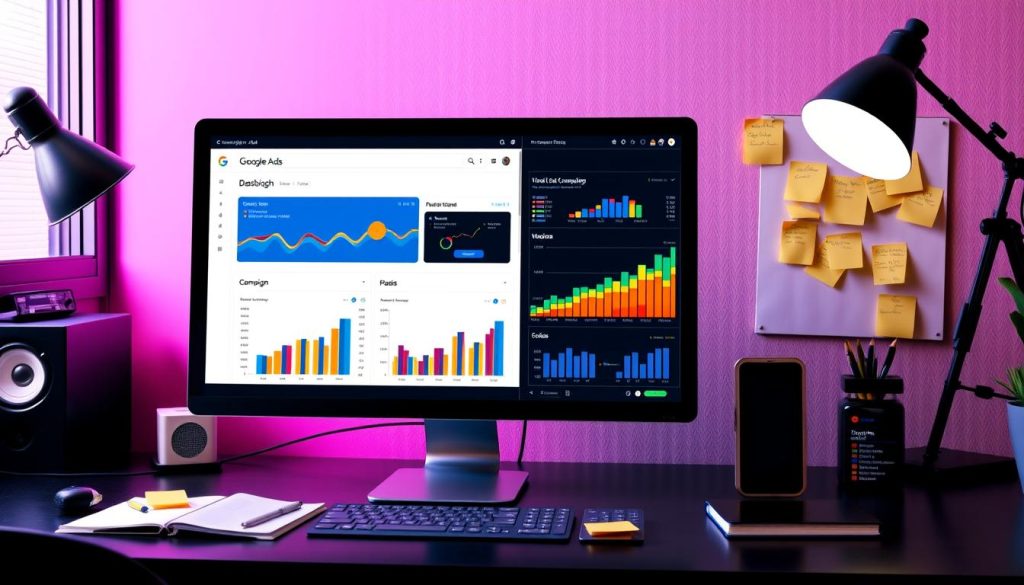Managing digital ads can seem overwhelming. But, with the right strategies and tools, businesses can make the most of their Google Ads campaigns through various Google Ads management scenarios. This guide will help you understand how to manage your campaigns. You’ll learn how to improve your Google Ads performance and get great returns on your marketing, especially when collaborating with a Google Ads agency.

Key Takeaways
- Explore the fundamental components of Google Ads campaign architecture to ensure a solid foundation for your advertising efforts.
- Discover strategic planning and goal-setting methods to align your campaigns with your business objectives and maximize ROI.
- Master advanced audience targeting techniques to reach the right customers and enhance the effectiveness of your ad campaigns.
- Understand the nuances of bid optimization, from manual to automated strategies, to fine-tune your campaigns for maximum impact.
- Optimize ad copy and test different creative approaches to captivate your target audience and drive conversions.
- Implement robust performance monitoring and analysis methods to identify areas for improvement and make data-driven decisions.
- Leverage troubleshooting techniques to address campaign challenges and maintain a competitive edge in the ever-evolving digital landscape.
Understanding Google Ads Campaign Architecture Fundamentals and Management Scenarios
To make a Google Ads campaign work well, you need to know its basic parts. These parts are the core of your ad strategy and include the campaign structure, ad groups, keywords, and ad extensions. Each part is vital for improving your campaign’s performance and quality score, especially when considering various Google Ads management scenarios.
Key Components of Campaign Structure
The Google Ads campaign structure has key parts that work together. They help send your message to the right people. These parts are:
- Campaigns: The main unit that groups ads by goals, budgets, and targets.
- Ad Groups: Smaller parts of a campaign that hold related ads and keywords. They help you control and improve your ads better.
- Ad Extensions: Extra details or features in your ads, like sitelinks or location info. They make your ads more visible and appealing.
Campaign Hierarchy and Organization
It’s important to organize your Google Ads campaigns well. A clear structure helps you manage and improve your ads. By setting up campaigns, ad groups, and keywords, you can match your ads with your business goals. This way, you can see how well your strategies work.
Setting Up Campaign Parameters
When starting your Google Ads campaigns, set up the parameters carefully. This means setting your campaign’s goals, budget, ad times, and targets. You also need to pick the right bidding strategy and ad quality score levels.
“Effective campaign architecture is the foundation for driving successful Google Ads performance. By understanding and implementing best practices, you can unlock the full potential of your advertising efforts.”
Google Ads Management Scenarios for Different Business Types
Creating a great Google Ads campaign needs a custom plan for each business type. Whether it’s big e-commerce sites or local services, each has its own challenges and chances. This is true for e-commerce advertising, lead generation, local business marketing, and B2B advertising.
E-commerce sites aim to boost online sales. They use targeted ads, dynamic remarketing, and smart bidding. It’s key to catch the right search queries and focus on making sales.
Service-based companies need to attract the right leads. They use smart targeting and ads that speak directly to their audience. Ads that show up based on location and call extensions work well for local business marketing.
B2B companies have a special challenge. They need to win over a tough, decision-making crowd. Using B2B advertising to show off expertise, thought leadership, and customer feedback builds trust. This leads to valuable leads.
| Business Type | Key Focus Areas | Recommended Strategies |
|---|---|---|
| E-commerce | e-commerce advertising, online sales, conversions | Product listings, dynamic remarketing, bid adjustments |
| Service-based | lead generation, location-based targeting | Audience targeting, personalized messaging, call extensions |
| B2B | B2B advertising, thought leadership, credibility | Industry expertise, customer testimonials, lead generation |
Knowing what each business needs helps marketers make Google Ads plans that really work. This way, they get the best results and make their ads pay off.
“Effective Google Ads management is not a one-size-fits-all approach. It’s about understanding the nuances of your target audience and aligning your tactics accordingly.”
Strategic Campaign Planning, Goal Setting, and Google Ads Management Scenarios
Creating a winning Google Ads campaign needs a smart plan. This plan should match your goals, budget, and how you’ll measure success. It’s the start of your ad journey, making sure your efforts are focused and measurable.
Defining Campaign Objectives
The first step is to set clear, SMART (Specific, Measurable, Achievable, Relevant, and Time-bound) goals. These goals should be clear, easy to track, and match your business needs. Whether you want to get more people to know your brand, visit your site, or make more sales, having specific goals helps you make better choices, especially when working with a Google Ads management agency.
Budget Allocation Strategies
Managing your advertising budget well is key to a great Google Ads campaign. Use data to decide how to spend your money on different ads and channels. Keep an eye on how your ads are doing and adjust your budget to get the best results.
Performance Metrics Selection
Picking the right KPIs (Key Performance Indicators) is vital to see if your ads are working. The right metrics depend on your goals, like how many people click on your ads or how many buy something. By watching these performance metrics closely, you can spot what’s working and what’s not, and make your ads even better.
“Careful planning and goal-setting are the foundations of a successful Google Ads campaign. By defining SMART objectives, allocating budgets strategically, and selecting the right performance metrics, you can set your campaigns up for long-term success.”
Advanced Audience Targeting Techniques
Google Ads can be a powerful tool when you target the right audience. Advanced techniques help you reach the right people at the right time, especially in various Adwords management scenarios. This boosts your campaign’s performance.
Creating custom audiences is a smart move. Use data like website visitors and email subscribers to make targeted groups. This way, your ads reach people who are most likely to be interested.
Remarketing is another great tactic. It helps you show ads to people who have shown interest in your brand before. This can encourage them to make a purchase, improving your campaign’s success.
Similar audiences help you find new people who might be interested in your products. It’s like finding new friends who share your interests. This can help your business grow.
In-market audiences target people who are actively looking for what you offer. This makes your ads more relevant and can increase your sales.
By using these advanced techniques, you can make your Google Ads campaigns better. You’ll offer more personalized ads, increase engagement, and see better results for your business.
| Audience Targeting Technique | Description | Key Benefits |
|---|---|---|
| Custom Audiences | Leverage first-party data to create highly tailored audiences | Reach most engaged and relevant potential customers |
| Remarketing | Reengage with users who have previously interacted with your brand | Convert warm leads and boost campaign efficiency |
| Similar Audiences | Expand reach by targeting users similar to your most valuable customers | Uncover new high-potential prospects |
| In-Market Audiences | Target users actively researching or considering products/services like yours | Improve campaign relevance and conversion rates |
“Mastering advanced audience targeting techniques is the key to unlocking unparalleled campaign performance and driving sustainable business growth.”
Creating Custom Bidding Strategies
Google Ads can be tough to navigate, but learning about custom bidding strategies is crucial. It helps you get the most out of your campaigns. Whether you want to boost your CPC, CPA, or ROAS, the right strategy is key.
Manual vs Automated Bidding
Choosing between manual and automated bidding is a big decision. Manual bidding lets you control every detail. But automated bidding, with its machine learning, is better for big or complex campaigns.
Smart Bidding Implementation
Smart bidding uses Google’s machine learning to adjust bids in real-time. It looks at lots of data to help you reach your goals more efficiently. This makes your campaigns more effective and precise.
Bid Adjustments for Different Scenarios
Adjusting bids for different times, places, or audiences is vital. It helps you get the best results from your campaigns. By fine-tuning your bids, you can improve your ROAS and optimize your bids.
“Effective bid optimization is the cornerstone of a successful Google Ads campaign. By understanding the nuances of manual and automated bidding, and leveraging smart bidding techniques, you can unlock the full potential of your digital marketing efforts.”
To create effective bidding strategies, you need to know your business, audience, and competitors well. By exploring manual and automated bidding, using smart bidding, and making smart adjustments, you can make your campaigns more efficient. This will help you achieve impressive ROAS.
Ad Copy Optimization and Testing Methods
Creating compelling ad copy is key to getting more clicks and conversions in your Google Ads campaigns. Use effective methods to make your ad messages better, and consider different approaches in various Google Ads management scenarios. Also, test rigorously to boost performance.
Begin by learning A/B testing. This method lets you compare different ad copy versions. Find out which one works best by trying different headlines, descriptions, and calls-to-action.
Use ad extensions to make your ads better. They offer extra details like sitelinks, callouts, and structured snippets. This can attract more potential customers.
Try responsive search ads for dynamic content that fits different devices and searches. Google will test various headlines and descriptions for you. This helps your ads perform better.
Lastly, focus on making your ads more relevant. Match your ad copy with what users are searching for. Make sure your messaging meets your audience’s needs and solves their problems.
| Tactic | Description | Key Benefits |
|---|---|---|
| A/B Testing | Comparing different versions of ad copy to identify the most effective approach | Optimizes ad performance, increases click-through rates and conversions |
| Ad Extensions | Enhancing ads with additional information like sitelinks, callouts, and structured snippets | Provides more details about products/services, improves ad visibility and engagement |
| Responsive Search Ads | Dynamic ad content that adapts to different devices and user queries | Optimizes ad relevance, improves performance across various search scenarios |
| Ad Relevance | Aligning ad copy with user intent and search keywords | Enhances the user experience, increases the likelihood of clicks and conversions |

By mastering these ad copy optimization and testing techniques, you can elevate your Google Ads campaigns to new heights, especially when applying them in various Google Ads management scenarios. This will drive better results and a higher return on your investment.
Campaign Performance Monitoring and Analysis
Tracking and analyzing your Google Ads campaigns is key to improving and reaching your marketing goals. Use Google Analytics, data visualization tools, and strategic tracking to find actionable insights. These insights help you optimize your campaigns and increase your return on investment.
Key Performance Indicators (KPIs)
First, identify the most important key performance indicators (KPIs) for your campaigns. Look at metrics like click-through rate, conversion rate, cost-per-acquisition, and return on ad spend. Watching these KPIs closely helps you see how well your campaigns are doing and where to make improvements.
Data Analysis Tools and Techniques
Use strong data analysis tools like Google Analytics to explore your campaign’s performance. Data visualization tools help you spot patterns, trends, and insights that guide your decisions. Use advanced segmentation, cohort analysis, and custom reports to fully understand your campaign’s performance.
Performance Reporting Templates
Make custom performance reporting templates to show your campaign’s progress clearly. These templates should have key metrics, data visuals, and clear actions to take. Regular reviews with stakeholders help keep your campaigns on track and aligned with your marketing strategy.
“Continuous monitoring and analysis of your Google Ads campaigns are crucial for driving long-term success. Leveraging the right tools and techniques can unlock valuable insights to guide your optimization efforts.”
Campaign Optimization and Troubleshooting
To get the best out of your Google Ads, you need to keep working on them. Learn how to boost quality scores, manage negative keywords, and improve ad rank. Also, make sure your landing pages are top-notch. This will help your campaigns perform better and give you a good return on investment.
Elevating Quality Scores
Quality score is key to how well your ads do. To up your quality scores, write ad copy that grabs attention and matches your keywords and landing pages. Also, make your landing pages easy to use and full of useful info. This will make your ads even better.
Negative Keyword Management
Negative keywords help you show ads only to the right people. Check and add to your negative keywords often. This keeps your ads from showing up for the wrong searches. It means more people who are actually interested in what you offer will see your ads.
Boosting Ad Rank
Ad rank shows where your ads appear on search pages. To get a better ad rank, work on your bids, quality scores, and ad extensions. This will help your ads show up more often and get more clicks and conversions.
Landing Page Optimization
Your landing pages are super important for your Google Ads success. Make sure they’re easy to use, have clear calls-to-action, and match your ad messaging. Keep testing and tweaking them to get the best results.
By using these tips, you can make your Google Ads campaigns work their best. You’ll see better quality scores, ad rank, and overall performance.

Conclusion
As we wrap up our exploration of Google Ads campaign management, remember it’s a continuous journey. Google Ads best practices demand ongoing learning and adaptation. This ensures your campaigns’ long-term success and drives great results for your business.
In this guide, we covered the basics of Google Ads campaign structure. We also looked at strategic planning, goal setting, and advanced techniques for targeting and ad optimization. These insights help you create campaigns that hit the mark with your audience and achieve success.
The real strength of Google Ads comes from constantly monitoring and improving your campaigns. Use KPIs and data tools to understand how your campaigns are doing. This way, you can always find ways to get better and stay ahead in a changing market.
FAQ
What are the key components of a Google Ads campaign structure?
A Google Ads campaign structure includes account setup, campaign types, ad groups, keywords, and ad extensions. It’s important to know how to organize and optimize these parts for success.
How can I effectively set up campaign parameters for optimal performance?
To optimize campaign parameters, think about your goals, target audience, budget, bid strategies, and ad schedules. Setting these up right ensures your campaigns will do well.
What are some advanced audience targeting techniques I can use in Google Ads?
Advanced techniques include creating custom audiences, using remarketing, and leveraging similar audiences. You can also use in-market audiences. These methods help you reach the right people and use your ad spend wisely.
How do I create effective bidding strategies to maximize campaign performance?
You can choose between manual and automated bidding. Use strategies like CPC, CPA, and ROAS bidding. Adjust bids for different scenarios to improve your campaigns.
What are some best practices for ad copy optimization and testing?
For ad copy optimization, try A/B testing, use ad extensions, and make responsive search ads. Also, improve ad relevance. Testing and refining your ad messaging can greatly improve performance.
How can I effectively monitor and analyze my Google Ads campaign performance?
To monitor performance, identify key indicators, use data tools, and create detailed reports. This helps you understand how to improve your campaigns.
What are some common optimization and troubleshooting strategies for Google Ads campaigns?
Common strategies include improving quality scores, managing negative keywords, and enhancing ad rank. Also, optimize landing pages. These steps help overcome challenges and increase ad spend return.

